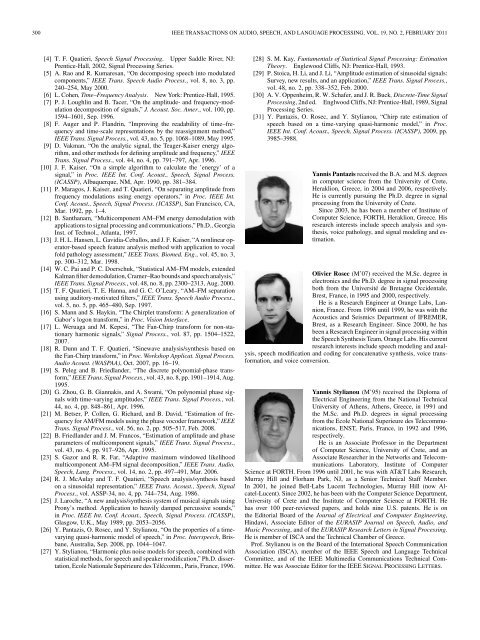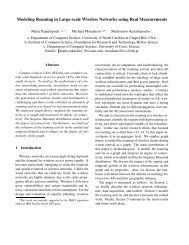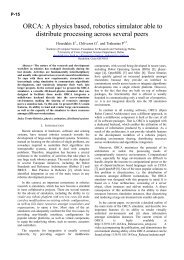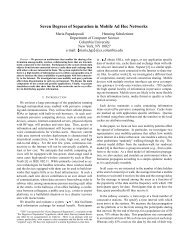Adaptive AM–FM Signal Decomposition With Application to ... - ICS
Adaptive AM–FM Signal Decomposition With Application to ... - ICS
Adaptive AM–FM Signal Decomposition With Application to ... - ICS
You also want an ePaper? Increase the reach of your titles
YUMPU automatically turns print PDFs into web optimized ePapers that Google loves.
300 IEEE TRANSACTIONS ON AUDIO, SPEECH, AND LANGUAGE PROCESSING, VOL. 19, NO. 2, FEBRUARY 2011<br />
[4] T. F. Quatieri, Speech <strong>Signal</strong> Processing. Upper Saddle River, NJ:<br />
Prentice-Hall, 2002, <strong>Signal</strong> Processing Series.<br />
[5] A. Rao and R. Kumaresan, “On decomposing speech in<strong>to</strong> modulated<br />
components,” IEEE Trans. Speech Audio Process., vol. 8, no. 3, pp.<br />
240–254, May 2000.<br />
[6] L. Cohen, Time–Frequency Analysis. New York: Prentice-Hall, 1995.<br />
[7] P. J. Loughlin and B. Tacer, “On the amplitude- and frequency-modulation<br />
decomposition of signals,” J. Acoust. Soc. Amer., vol. 100, pp.<br />
1594–1601, Sep. 1996.<br />
[8] F. Auger and P. Flandrin, “Improving the readability of time–frequency<br />
and time-scale representations by the reassignment method,”<br />
IEEE Trans. <strong>Signal</strong> Process., vol. 43, no. 5, pp. 1068–1089, May 1995.<br />
[9] D. Vakman, “On the analytic signal, the Teager-Kaiser energy algorithm,<br />
and other methods for defining amplitude and frequency,” IEEE<br />
Trans. <strong>Signal</strong> Process., vol. 44, no. 4, pp. 791–797, Apr. 1996.<br />
[10] J. F. Kaiser, “On a simple algorithm <strong>to</strong> calculate the ’energy’ of a<br />
signal,” in Proc. IEEE Int. Conf. Acoust., Speech, <strong>Signal</strong> Process.<br />
(ICASSP), Albuquerque, NM, Apr. 1990, pp. 381–384.<br />
[11] P. Maragos, J. Kaiser, and T. Quatieri, “On separating amplitude from<br />
frequency modulations using energy opera<strong>to</strong>rs,” in Proc. IEEE Int.<br />
Conf. Acoust., Speech, <strong>Signal</strong> Process. (ICASSP), San Francisco, CA,<br />
Mar. 1992, pp. 1–4.<br />
[12] B. Santhanam, “Multicomponent <strong>AM–FM</strong> energy demodulation with<br />
applications <strong>to</strong> signal processing and communications,” Ph.D., Georgia<br />
Inst. of Technol., Atlanta, 1997.<br />
[13] J. H. L. Hansen, L. Gavidia-Ceballos, and J. F. Kaiser, “A nonlinear opera<strong>to</strong>r-based<br />
speech feature analysis method with application <strong>to</strong> vocal<br />
fold pathology assessment,” IEEE Trans. Biomed. Eng., vol. 45, no. 3,<br />
pp. 300–312, Mar. 1998.<br />
[14] W. C. Pai and P. C. Doerschuk, “Statistical <strong>AM–FM</strong> models, extended<br />
Kalman filter demodulation, Cramer–Rao bounds and speech analysis,”<br />
IEEE Trans. <strong>Signal</strong> Process., vol. 48, no. 8, pp. 2300–2313, Aug. 2000.<br />
[15] T. F. Quatieri, T. E. Hanna, and G. C. O’Leary, “<strong>AM–FM</strong> separation<br />
using audi<strong>to</strong>ry-motivated filters,” IEEE Trans. Speech Audio Process.,<br />
vol. 5, no. 5, pp. 465–480, Sep. 1997.<br />
[16] S. Mann and S. Haykin, “The Chirplet transform: A generalization of<br />
Gabor’s logon transform,” in Proc. Vision Interface.<br />
[17] L. Weruaga and M. Kepesi, “The Fan-Chirp transform for non-stationary<br />
harmonic signals,” <strong>Signal</strong> Process., vol. 87, pp. 1504–1522,<br />
2007.<br />
[18] R. Dunn and T. F. Quatieri, “Sinewave analysis/synthesis based on<br />
the Fan-Chirp transform,” in Proc. Workshop Applicat. <strong>Signal</strong> Process.<br />
Audio Acoust. (WASPAA), Oct. 2007, pp. 16–19.<br />
[19] S. Peleg and B. Friedlander, “The discrete polynomial-phase transform,”<br />
IEEE Trans. <strong>Signal</strong> Process., vol. 43, no. 8, pp. 1901–1914, Aug.<br />
1995.<br />
[20] G. Zhou, G. B. Giannakis, and A. Swami, “On polynomial phase signals<br />
with time-varying amplitudes,” IEEE Trans. <strong>Signal</strong> Process., vol.<br />
44, no. 4, pp. 848–861, Apr. 1996.<br />
[21] M. Betser, P. Collen, G. Richard, and B. David, “Estimation of frequency<br />
for AM/FM models using the phase vocoder framework,” IEEE<br />
Trans. <strong>Signal</strong> Process., vol. 56, no. 2, pp. 505–517, Feb. 2008.<br />
[22] B. Friedlander and J. M. Francos, “Estimation of amplitude and phase<br />
parameters of multicomponent signals,” IEEE Trans. <strong>Signal</strong> Process.,<br />
vol. 43, no. 4, pp. 917–926, Apr. 1995.<br />
[23] S. Gazor and R. R. Far, “<strong>Adaptive</strong> maximum windowed likelihood<br />
multicomponent <strong>AM–FM</strong> signal decomposition,” IEEE Trans. Audio,<br />
Speech, Lang. Process., vol. 14, no. 2, pp. 497–491, Mar. 2006.<br />
[24] R. J. McAulay and T. F. Quatieri, “Speech analysis/synthesis based<br />
on a sinusoidal representation,” IEEE Trans. Acoust., Speech, <strong>Signal</strong><br />
Process., vol. ASSP-34, no. 4, pp. 744–754, Aug. 1986.<br />
[25] J. Laroche, “A new analysis/synthesis system of musical signals using<br />
Prony’s method. <strong>Application</strong> <strong>to</strong> heavily damped percussive sounds,”<br />
in Proc. IEEE Int. Conf. Acoust., Speech, <strong>Signal</strong> Process. (ICASSP),<br />
Glasgow, U.K., May 1989, pp. 2053–2056.<br />
[26] Y. Pantazis, O. Rosec, and Y. Stylianou, “On the properties of a timevarying<br />
quasi-harmonic model of speech,” in Proc. Interspeech, Brisbane,<br />
Australia, Sep. 2008, pp. 1044–1047.<br />
[27] Y. Stylianou, “Harmonic plus noise models for speech, combined with<br />
statistical methods, for speech and speaker modification,” Ph.D. dissertation,<br />
Ecole Nationale Supérieure des Télécomm., Paris, France, 1996.<br />
[28] S. M. Kay, Funtamentals of Statistical <strong>Signal</strong> Processing: Estimation<br />
Theory. Englewood Cliffs, NJ: Prentice-Hall, 1993.<br />
[29] P. S<strong>to</strong>ica, H. Li, and J. Li, “Amplitude estimation of sinusoidal signals:<br />
Survey, new results, and an application,” IEEE Trans. <strong>Signal</strong> Process.,<br />
vol. 48, no. 2, pp. 338–352, Feb. 2000.<br />
[30] A. V. Oppenheim, R. W. Schafer, and J. R. Buck, Discrete-Time <strong>Signal</strong><br />
Processing, 2nd ed. Englwood Cliffs, NJ: Prentice-Hall, 1989, <strong>Signal</strong><br />
Processing Series.<br />
[31] Y. Pantazis, O. Rosec, and Y. Stylianou, “Chirp rate estimation of<br />
speech based on a time-varying quasi-harmonic model,” in Proc.<br />
IEEE Int. Conf. Acoust., Speech, <strong>Signal</strong> Process. (ICASSP), 2009, pp.<br />
3985–3988.<br />
Yannis Pantazis received the B.A. and M.S. degrees<br />
in computer science from the University of Crete,<br />
Heraklion, Greece, in 2004 and 2006, respectively.<br />
He is currently pursuing the Ph.D. degree in signal<br />
processing from the University of Crete.<br />
Since 2003, he has been a member of Institute of<br />
Computer Science, FORTH, Heraklion, Greece. His<br />
research interests include speech analysis and synthesis,<br />
voice pathology, and signal modeling and estimation.<br />
Olivier Rosec (M’07) received the M.Sc. degree in<br />
electronics and the Ph.D. degree in signal processing<br />
both from the Université de Bretagne Occidentale,<br />
Brest, France, in 1995 and 2000, respectively.<br />
He is a Research Engineer at Orange Labs, Lannion,<br />
France. From 1996 until 1999, he was with the<br />
Acoustics and Seismics Department of IFREMER,<br />
Brest, as a Research Engineer. Since 2000, he has<br />
been a Research Engineer in signal processing within<br />
the Speech Synthesis Team, Orange Labs. His current<br />
research interests include speech modeling and analysis,<br />
speech modification and coding for concatenative synthesis, voice transformation,<br />
and voice conversion.<br />
Yannis Stylianou (M’95) received the Diploma of<br />
Electrical Engineering from the National Technical<br />
University of Athens, Athens, Greece, in 1991 and<br />
the M.Sc. and Ph.D. degrees in signal processing<br />
from the Ecole National Superieure des Telecommunications,<br />
ENST, Paris, France, in 1992 and 1996,<br />
respectively.<br />
He is an Associate Professor in the Department<br />
of Computer Science, University of Crete, and an<br />
Associate Researcher in the Networks and Telecommunications<br />
Labora<strong>to</strong>ry, Institute of Computer<br />
Science at FORTH. From 1996 until 2001, he was with AT&T Labs Research,<br />
Murray Hill and Florham Park, NJ, as a Senior Technical Staff Member.<br />
In 2001, he joined Bell-Labs Lucent Technologies, Murray Hill (now Alcatel-Lucent).<br />
Since 2002, he has been with the Computer Science Department,<br />
University of Crete and the Institute of Computer Science at FORTH. He<br />
has over 100 peer-reviewed papers, and holds nine U.S. patents. He is on<br />
the Edi<strong>to</strong>rial Board of the Journal of Electrical and Computer Engineering,<br />
Hindawi, Associate Edi<strong>to</strong>r of the EURASIP Journal on Speech, Audio, and<br />
Music Processing, and of the EURASIP Research Letters in <strong>Signal</strong> Processing.<br />
He is member of ISCA and the Technical Chamber of Greece.<br />
Prof. Stylianou is on the Board of the International Speech Communication<br />
Association (ISCA), member of the IEEE Speech and Language Technical<br />
Committee, and of the IEEE Multimedia Communications Technical Committee.<br />
He was Associate Edi<strong>to</strong>r for the IEEE SIGNAL PROCESSING LETTERS.
















